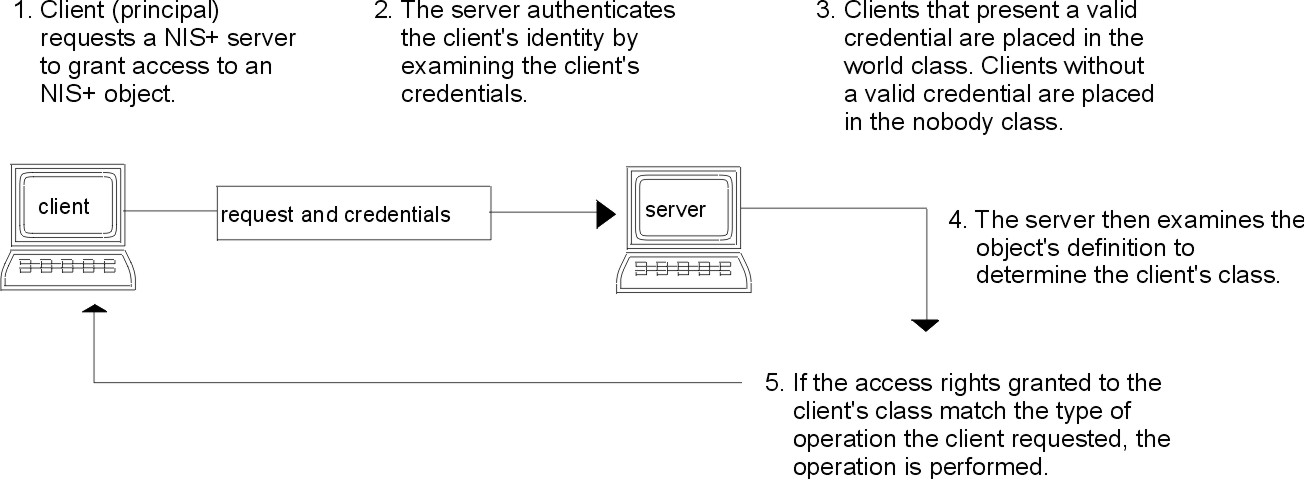
NIS+ security is an integral part of the NIS+ namespace. You cannot set up security independently from the namespace. For this reason, instructions for setting up security are woven through the steps used to set up the other components of the namespace. Once an NIS+ security environment has been set up, you can add and remove users, change permissions, reassign group members, and perform all other routine administrative tasks needed to manage an evolving network.
The security features of NIS+ protect the information in the namespace, as well as the structure of the namespace itself, from unauthorized access. Without these security features, any NIS+ client could obtain, change, or even damage information stored in the namespace.
NIS+ security serves two purposes:
For example, a given NIS+ table may allow one class to both read and modify the information in the table, but a different class is only allowed to read the information, and a third class is not even allowed to do that. This is similar in concept to the operating system's file and directory permissions system. (See Authorization Classes for more information on classes.)
Authentication and authorization prevents someone with root privileges on machine A from using the su command to assume the identity of a second user who is either not logged in at all or logged in on machine B, and then accessing NIS+ objects with the second user's NIS+ access privileges.
Note, however, that NIS+ cannot prevent someone who knows another user's login password from assuming that other user's identity and NIS+ access privileges. Nor can NIS+ prevent a user with root privileges from assuming the identity of another user who is logged in from the same machine.
The following figure details this process.
Figure 7-1. Summary of NIS+ Security Process. This illustration shows a representation of the NIS+ security process.
 |
NIS+ principals are the entities (clients) that submit requests for NIS+ services. An NIS+ principal may be someone who is logged in to a client machine as a regular user, someone who is logged in as root user, or any process that runs with root user permission on an NIS+ client machine. Thus, an NIS+ principal can be a client user or a client workstation.
An NIS+ principal can also be the entity that supplies an NIS+ service from an NIS+ server. Because all NIS+ servers are also NIS+ clients, much of this discussion also applies to servers.
NIS+ servers operate at one of two security levels. These levels determine the types of credential principals must submit for their requests to be authenticated. NIS+ is designed to run at the most secure level, which is security level 2. Level 0 is provided only for testing, setup, and debugging purposes. These security levels are summarized in the following table.
Note: Use Web-based System Manager, SMIT, or the passwd command to change your own password regardless of security level or credential status.
| NIS+ Security Levels | |
|---|---|
| Security Level | Description |
| 0 | Security level 0 is designed for testing and setting up the initial NIS+ namespace. An NIS+ server running at security level 0 grants any NIS+ principal full access rights to all NIS+ objects in the domain. Level 0 is for setup purposes only and should only be used by administrators for that purpose. Level 0 should not be used on networks in normal operation by regular users. |
| 1 | Security level 1 uses AUTH_SYS security. This level is not supported by NIS+ and should not be used. |
| 2 | Security level 2 is the default. The highest level of security currently provided by NIS+, it authenticates only requests that use data encryption standard (DES) credentials. Requests with no credentials are assigned to the nobody class and have whatever access rights have been granted to that class. Requests that use invalid DES credentials are retried. After repeated failure to obtain a valid DES credential, requests with invalid credentials fail with an authentication error. (A credential might not be valid for a variety of reasons, such as the principal making the request is not logged in through keylogin on that machine, the clocks are out of sync, there is a key mismatch, and so on.) |